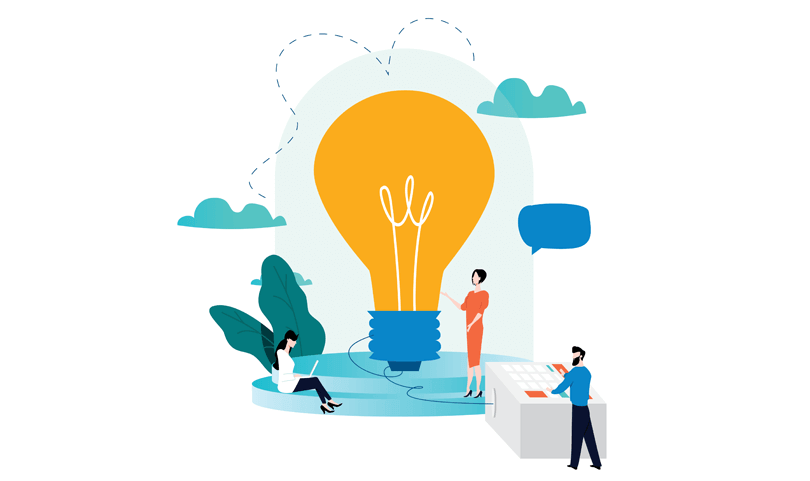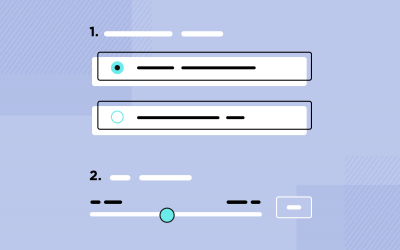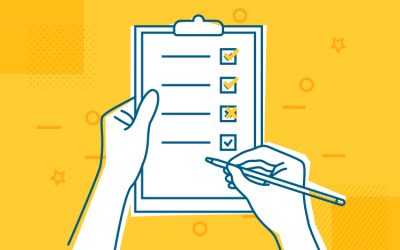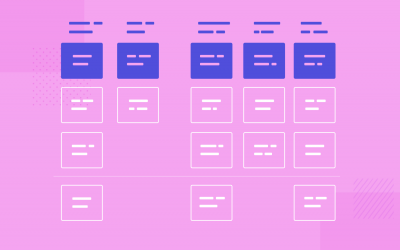Going from idea to final product involves many steps. In this post we’ll cover what differentiates prototyping from minimum viable product in the design process
As designers, we need to know what we’re building. That entails understanding the subtle but vital differences between a prototype and a minimum viable product.
Prototypes and a minimum viable product are both product design approaches that are used to validate hypotheses.
Create prototypes and MVPs today. Enjoy unlimited projects.

In this post, we’ll uncover just what the difference is between the two approaches.
A prototype is a sample. It is a taster of what will eventually become a final product. Although, not all prototypes will become a final product.
Prototypes are as much about exploring ideas as they are about developing those ideas further. They come in many different shapes and sizes from paper prototypes to sketches all the way to fully functional interactive prototypes. Along the way, there are usually many stops in things like high or low-fidelity prototypes.
There is a raft of tools out there, each with its own focus. Some, like Justinmind’s prototyping tool, allow designers to simply drag and drop widgets onto a canvas for effortless prototyping.

Prototyping plays a critical role within the design process for this reason. You might have an idea for a mobile app or website that you decide to explore in your website prototyping tool. After a while, you’ll realize whether the idea works or not.
That is the beauty of prototypes. They are non-committal and can be used in every stage of the design process. Whether it’s about actualizing an idea from your mind or iterating on something already created, prototyping is a powerful way to explore concepts, understand usability and improve functionality.
Prototypes have many benefits:
- They are quick to make
- They’re inexpensive
- They reduce costs and time-to-market
An MVP is a minimum viable product. It was born out of the Lean mentality pioneered by Eric Ries.
He describes an MVP as a synthesis of two extremes. There is one school of thought, when it comes to product design, that’s very much a case of “we have one shot at this, let’s get it right by building the most perfect product possible”.
This seems like a rational approach. But what happens after 5 years of research and development only to discover nobody wants your product?
The other school of thought is to release early, release often and listen to what customers say and iterate on that.
Basically, MVP is: what is the minimum set of features necessary to engage early adopters and start the learning-feedback loop. It helps entrepreneurs start the process of learning quickly as possible. This image illustrates MVP perfectly:
When it comes to creating an MVP, it’s about ensuring that you don’t over-engineer or under engineer so you can successfully launch a product. The reason for this is that you need an MVP in order to find out what parts you should build next, or which parts weren’t necessary all along.
A product shouldn’t be fully fleshed out because an MVP helps you to understand your product, audience, and requirements better.
Create prototypes and MVPs today. Enjoy unlimited projects.

Take prototypes. They’re great for getting stakeholders on board, especially after a killer presentation. An early cash injection from initial investors after a successful presentation can then create a new focus for the prototype: deployment into production. That’s when designers will need to create an MVP.
MVPs are used to gain insight from early adopters of a product. Now, all this might sound eerily similar to a prototype. Let’s dive deeper.
An MVP is a prototype at its heart but further along in the product development process. An MVP will be created once you have tested out any hypotheses through prototyping and got proof of concept. Ideally, you’ll create the minimum version (which you’ll improve) of your product and share it with the biggest number of people.
In essence, a prototype is the foundation for what will become the minimum viable product. Kurt Stangl gives great insight into how he got his MVP up and ready in less than a month.
It’s important to have an MVP because of the 30,000 new consumer products that are launched a year, 95% fail.
The benefits of having an MVP are:
- Winning over stakeholders
- Helps to evolve your product
- Minimize development costs
- Quicker to get to release
Prototypes and minimum viable products don’t sound wildly different and when you think about it, they’re not. But there are a few key fundamental differences that set them apart from one another. The biggest difference is, as the name suggests, viability.
Alex Iskold wrote that an MVP is good enough and can be improved to be great one day. A prototype isn’t good enough. An MVP has the potential to fully solve the problem at hand.

That doesn’t mean the prototype is obsolete. Far from it. If we look at when you’d build a prototype versus when you’d build an MVP we can glean differences.
You might design and create a prototype after having an idea and discussing it with friends or colleagues. The product is unproven at this moment. There’s only you, your idea, and your favorite app prototyping tool. You’ve probably got no funding at this point and you don’t fully understand the risks involved. In these instances, prototypes are ideal because, as we mentioned, they’re non-committal.
It’s only when you understand the product more and have a business case that the MVP comes into play. By mitigating any risks and getting some funding, the MVP can be created.
Prototyping helps us to understand the feasibility of an idea where the MVP is more about validated learning, which is one of the principles of the Lean Startup.
To quote Ries again:
“The unit of progress for Lean Startups is validated learning – a rigorous method for demonstrating progress when one is embedded in the soil of extreme uncertainty. Once entrepreneurs embrace validated learning, the development process can shrink substantially.
When you focus on figuring out the right thing to build – the thing customers want and will pay for-you need not spend months waiting for a product beta launch to change the company’s direction.”
Uber, Airbnb and Dropbox released MVPs in order to achieve rapid growth. And boy, did they grow rapidly. Now they’re some of the most used companies in the world.
Look at the video which launched Dropbox to the world, narrated by founder Drew Houston in 2007:
Create prototypes and MVPs today. Enjoy unlimited projects.

What’s interesting about Dropbox is that this video targeted a specific niche of early adopters, as you’d expect from an MVP, but within 7 months they had 1 million users.
Dropbox created the video which demoed their first build. Drew briefly explains the core value proposition and shows how easy it is to share files across several devices even on different operating systems.
The video is crucial in Dropbox’s case because it is what was used to understand whether or not the product had any market viability. It worked.
Dropbox’s signups increased from 5,000 people to 75,000. This little 3-minute video served as the validation they needed, all before Dropbox had funds, infrastructure, or development.
When it comes to product design and product launch, you’ll invariably need to get your head around both prototyping and MVP. Each approach plays a fundamental role in the design process and knowing what and how to create each one is key to successful product design.
PROTOTYPE · COMMUNICATE · VALIDATE
ALL-IN-ONE PROTOTYPING TOOL FOR WEB AND MOBILE APPS
Related Content
 Creating a good survey involves a lot of different factors, but what makes a great survey? Check out these examples for serious inspiration!12 min Read
Creating a good survey involves a lot of different factors, but what makes a great survey? Check out these examples for serious inspiration!12 min Read Prototyping is a door to validating requirements, but how can we test requirements? How does Justinmind help us validate my requirements?6 min Read
Prototyping is a door to validating requirements, but how can we test requirements? How does Justinmind help us validate my requirements?6 min Read Find out how this basic yet powerful technique can help organize your team and boost your product's UX. Discover useful tools and books to help you get it done.10 min Read
Find out how this basic yet powerful technique can help organize your team and boost your product's UX. Discover useful tools and books to help you get it done.10 min Read


